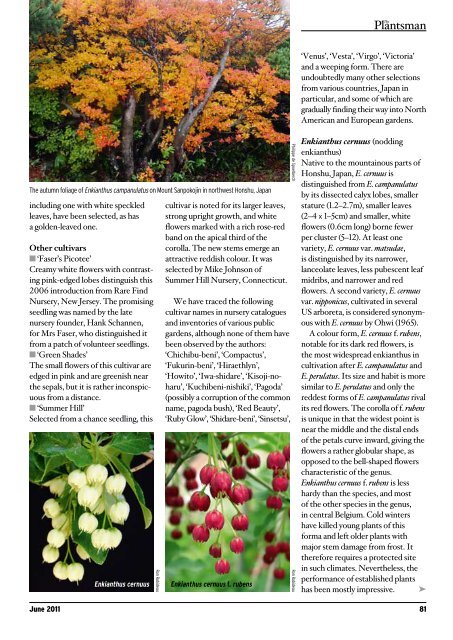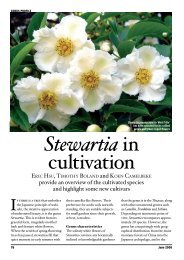Enkianthus - The Polly Hill Arboretum
Enkianthus - The Polly Hill Arboretum
Enkianthus - The Polly Hill Arboretum
Create successful ePaper yourself
Turn your PDF publications into a flip-book with our unique Google optimized e-Paper software.
<strong>The</strong> autumn foliage of <strong>Enkianthus</strong> campanulatus on Mount Sanpokojin in northwest Honshu, Japan<br />
including one with white speckled<br />
leaves, have been selected, as has<br />
a golden-leaved one.<br />
Other cultivars<br />
n ‘Faser’s Picotee’<br />
Creamy white flowers with contrasting<br />
pink-edged lobes distinguish this<br />
2006 introduction from Rare Find<br />
Nursery, New Jersey. <strong>The</strong> promising<br />
seedling was named by the late<br />
nursery founder, Hank Schannen,<br />
for Mrs Faser, who distinguished it<br />
from a patch of volunteer seedlings.<br />
n ‘Green Shades’<br />
<strong>The</strong> small flowers of this cultivar are<br />
edged in pink and are greenish near<br />
the sepals, but it is rather inconspicuous<br />
from a distance.<br />
n ‘Summer <strong>Hill</strong>’<br />
Selected from a chance seedling, this<br />
June 2011<br />
<strong>Enkianthus</strong> cernuus<br />
Ron Rabideau<br />
cultivar is noted for its larger leaves,<br />
strong upright growth, and white<br />
flowers marked with a rich rose-red<br />
band on the apical third of the<br />
corolla. <strong>The</strong> new stems emerge an<br />
attractive reddish colour. It was<br />
selected by Mike Johnson of<br />
Summer <strong>Hill</strong> Nursery, Connecticut.<br />
We have traced the following<br />
cultivar names in nursery catalogues<br />
and inventories of various public<br />
gardens, although none of them have<br />
been observed by the authors:<br />
‘Chichibu-beni’, ‘Compactus’,<br />
‘Fukurin-beni’, ‘Hiraethlyn’,<br />
‘Howito’, ‘Iwa-shidare’, ‘Kisoji-noharu’,<br />
‘Kuchibeni-nishiki’, ‘Pagoda’<br />
(possibly a corruption of the common<br />
name, pagoda bush), ‘Red Beauty’,<br />
‘Ruby Glow’, ‘Shidare-beni’, ‘Sinsetsu’,<br />
<strong>Enkianthus</strong> cernuus f. rubens<br />
Philippe de Spoelberch<br />
Ron Rabideau<br />
<strong>The</strong><br />
Plantsman<br />
‘Venus’, ‘Vesta’, ‘Virgo’, ‘Victoria’<br />
and a weeping form. <strong>The</strong>re are<br />
undoubtedly many other selections<br />
from various countries, Japan in<br />
particular, and some of which are<br />
gradually finding their way into North<br />
American and European gardens.<br />
<strong>Enkianthus</strong> cernuus (nodding<br />
enkianthus)<br />
Native to the mountainous parts of<br />
Honshu, Japan, E. cernuus is<br />
distinguished from E. campanulatus<br />
by its dissected calyx lobes, smaller<br />
stature (1.2–2.7m), smaller leaves<br />
(2–4 x 1–5cm) and smaller, white<br />
flowers (0.6cm long) borne fewer<br />
per cluster (5–12). At least one<br />
variety, E. cernuus var. matsudae,<br />
is distinguished by its narrower,<br />
lanceolate leaves, less pubescent leaf<br />
midribs, and narrower and red<br />
flowers. A second variety, E. cernuus<br />
var. nipponicus, cultivated in several<br />
US arboreta, is considered synonymous<br />
with E. cernuus by Ohwi (1965).<br />
A colour form, E. cernuus f. rubens,<br />
notable for its dark red flowers, is<br />
the most widespread enkianthus in<br />
cultivation after E. campanulatus and<br />
E. perulatus. Its size and habit is more<br />
similar to E. perulatus and only the<br />
reddest forms of E. campanulatus rival<br />
its red flowers. <strong>The</strong> corolla of f. rubens<br />
is unique in that the widest point is<br />
near the middle and the distal ends<br />
of the petals curve inward, giving the<br />
flowers a rather globular shape, as<br />
opposed to the bell-shaped flowers<br />
characteristic of the genus.<br />
<strong>Enkianthus</strong> cernuus f. rubens is less<br />
hardy than the species, and most<br />
of the other species in the genus,<br />
in central Belgium. Cold winters<br />
have killed young plants of this<br />
forma and left older plants with<br />
major stem damage from frost. It<br />
therefore requires a protected site<br />
in such climates. Nevertheless, the<br />
performance of established plants<br />
has been mostly impressive. ➤<br />
81



